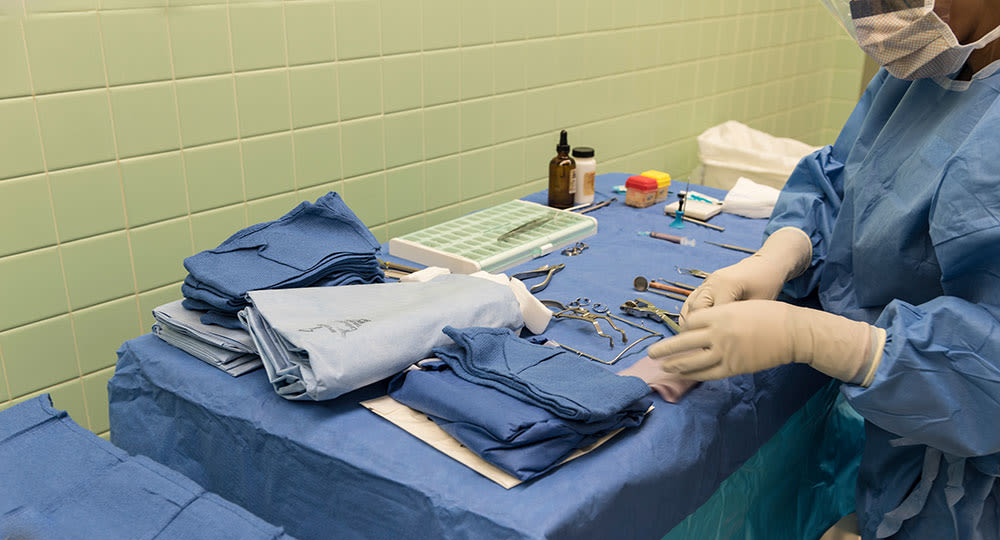
There are broadly two types of surgical drapes: disposable and reusable. Though it might seem logically obvious that disposable drapes should have a lower risk of causing surgical site infections (SSIs), the evidence is actually mixed as to which is better for reducing patient SSI risk.
The Basics of Surgical Drapes
Surgical drapes are a type of medical drape used in surgical settings to help protect doctors, patients and equipment, so bodily fluids and other material that may carry pathogens pass less freely around the operating room. Surgical drapes are a relatively simple, effective way to create a hygienic barrier that reduces SSI risk.
However, several unknowns exist regarding surgical risks. Although the topic of surgical drapes has been studied, evidence is currently inconclusive as to whether disposable drapes or reusable drapes may be more effective at reducing a patient’s risk of complications.
Disposable Drapes
When it comes to reducing SSI risk, many healthcare professionals gravitate toward these drapes because theoretically, their disposable nature means it is difficult for these drapes to transmit pathogens. However, as discussed further in our section on the science of surgical drapes, there is mixed evidence regarding whether disposable drapes actually provide any significant advantage when it comes to SSI risk.
Reusable Drapes
Reusable surgical drapes are typically made of woven materials. They are designed to be laundered, sterilized and reused after a procedure.
With proper care, using reusable drapes should result in savings over disposable surgical drapes. The obvious caveat is that the drapes must be well-cleaned between uses to maintain proper hygiene. If they aren’t disinfected, they can pose a transmission risk.
The Science Behind Surgical Drapes
Multiple studies have examined surgical drapes made of multiple and single-use materials and the results have been mixed. One study found some benefits to using disposable nonwoven drapes to reduce SSI risk, but the effect wasn’t statistically significant.
The potential harm of using one type of drape over another is therefore, at least as far as research has shown, minimal. However, the adhesive bands that help keep single-use drapes in place can cause a skin rash or eczema. Additionally, an allergic reaction is possible with some types of drapes, notably the use of iodophor-impregnated drapes.
The systematic review we referenced for this article noted, the “available evidence is limited and comes mainly from high-income countries.” It emphasized that more research is needed before one can conclusively declare one type of drape superior to the other, making this a topic medical professionals will want to regularly review for new findings.
The review also pointed out, “[t]he use of adhesive incise drapes is not considered a high priority topic in the field of SSI prevention research.” This isn’t to say this issue doesn’t matter, but other issues contribute more significantly to SSI risk than surgical drape selection.
Other Considerations for Surgical Drapes in Hospitals and Emergency Rooms
Cost is an obvious factor to be considered when choosing surgical drapes, especially considering the mixed evidence on whether reusable or disposable drapes have any significant patient benefits. There doesn’t appear to be much research into this topic available either, although the cost pattern should generally hold as expected.
Disposable drapes will be more costly than reusable drapes over time because they can’t be reused. The detailed cost breakdown can vary greatly, depending on the drapes used, the scale of a company’s operation and how cost-effectively a company can launder and sterilize its drapes.
Brand and material (which also relate to cost) are additional considerations when selecting drapes. Reusable drapes are made from tightly woven textiles or knitted cotton. They also may come in the form of other fabrics that may be blended with polyester or be chemically treated.
Disposable drapes come in a variety of nonwoven materials, both synthetic and natural. The material used should be impermeable to fluids and bacteria.
Which Type of Drape Is Better?
Overall, evidence as to whether there is a significant difference in SSI risk between reusable or disposable drapes is limited. At the same time, some respected healthcare organizations make drape recommendations. For example, the guidelines of the Society for Healthcare Epidemiology of America (SHEA)/Infectious Diseases Society of America (IDSA) issued in 2014 recommended against routinely using plastic adhesive drapes, including those with antimicrobial properties.
Medical experts’ stance on this issue will continue to evolve as more research is done on the subject. For now, there isn’t a consensus regarding which type of drapes a care provider should use.
Let Alsco Uniforms Help To Outfit Your Hospital or Emergency Room
At Alsco Uniforms, we can ensure that your hospital, emergency room or other medical facility is equipped with all needed linens, including drapes. Click here to learn about our healthcare rental services and see what we can offer your business.
You can also click here to read another article our team wrote about the disinfectants commonly used in hospitals to further your understanding of hygiene as it relates to medical and healthcare settings.
References
Does the Type of Surgical Drape (Disposable Versus Non-Disposable) Affect the Risk of Subsequent Surgical Site Infection? (May 2018). Journal of Orthopaedics.
Global Guidelines for the Prevention of Surgical Site Infection. (2018). World Health Organization.
